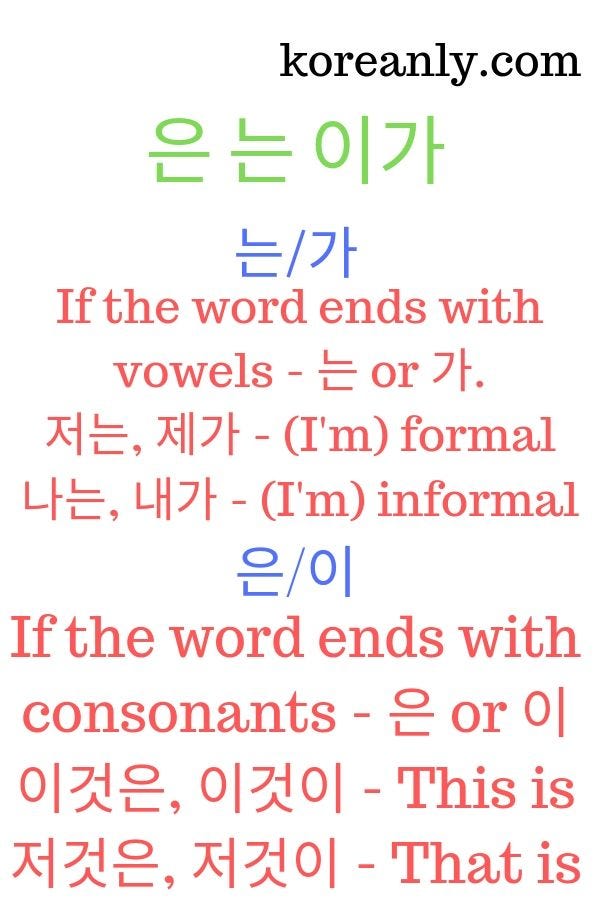
Topic marker and subject marker in Korean!! 은 는 이 가 r/BeginnerKorean
Rule 2: Comparison. Another difference between 이/가 and 은/는 is that when you are making a comparison, typically in the format of 'A is so-and-so, as for B…' you use the topic marker 는/은. For example if you want to compare the weather between yesterday and today. 어제 비가 왔는데 오늘 은 날씨가 좋다.

Learn Korean 은는이가을를/Korean grammar [4] 은,는,이,가,을,를 YouTube
안녕하세요~! 토미입니다! Today, I will teach you how to distinguish the topic marker 은/는 and the subject marker, 이/가. In Korean grammar, the concept of particles takes an important role in defining the relationship that words have in a sentence. In Korean, you should add a particle right after each main word so that it is easy for the listener to understand.

Learning Korean 01 은/는/이/가 YouTube
The identifier particle, 가/이, identifies the subject of a sentence. 가/이 is concerned about who did the things asked. Like the 는/은 example above, 가 is used for words without a final consonant and 이 for words with a final consonant. 동생이 먹었다 = Younger brother/sister ate (It wasn't someone else but them)
N은/는 vs 이/가 = 'topic marker' vs 'subject marker' in Korean yonseikorea
3. The 는 and 은 markers are "topic markers" and are used when introducing a new subject. The 가 and 이 markers are "subject markers" and are used when discussing a known topic. The difference can be subtle. For example, "책은 재미있다" and "책이 재미있다" both translate to "this book is interesting," but the first one implies.

[Learn Korean] Grammar PARTICLES 은 는 이 가 YouTube
When to use 은/는 There are 4 times when 은/는 should be used: 1. General statement: When you are giving general statements/facts about a noun 제 이름은 빅키입니다 - my name is Vicky 저는 여자입니다 - I am a woman 저는 한국인입니다 - I am Korean 2. Put emphasis on the general fact of the subject You can think of this as meaning "when it comes to SUBJECT,."

Korean grammar — 은/는 이/가. Korean grammar — 은/는 이/가 Definition by
For example, in this sentence: "I ate a hamburger". "I" is the subject of the sentence. "Hamburger" is the object. "Eat" is the verb. In this Lesson, you will learn about the particles ~이/가 and specifically how it can compare with ~는/은. In all situations, ~이 is attached to nouns in which the last letter is a consonant.

[korean grammar] Comparing 이/가 vs 은/는 YouTube
What are Korean Particles? Korean particles mainly function as markers in a sentence. These words help identify what a certain word's role is in the sentence (whether it's the topic or the object), and it also helps connect words to give a clearer meaning to what you want to say.

한국어 문법10 14 은/는/이/가 Korean Grammar10 14 은/는/이/가 YouTube
How to Use 은/는/이/가 ?! Korean Subject & Topic Markers Minji Teaches Korean 민지 티치 코리안 211K subscribers Subscribe 16K 365K views 6 years ago # Basic Korean Lesson 안녕하세요 여러분 ! In order to.

Korean Particles HOW TO Use 은/는, 이/가 and 을/를 Flexi Classes
To be short, 이/가 is used mostly to emphasize the very subject the speaker is mentioning. Like, 제이슨이 문을 두드렸어. (Jason knocked the door.) In this sentence, the speaker is emphasizing the fact that it was "Jason", not anyone else, who knocked the door. However, if the speaker put 은/는 in the same sentence like.

[Advanced] Topic Marker 은[eun]/는[neun] vs. Subject Marker 이[i]/가[ga
Don't worry. Below we will explain in detail what Korean particles are and provide plenty of examples to help you learn how to use Korean particles in Korean sentences. (FYI - This lesson includes both Korean characters and English romanization.

Studying Korean_How to use 은, 는, 이, 가 YouTube
이/가 and 은/는 are two of the most frequently used particles in the Korean language. At the same time, they are usually the most confusing particles for Korean learners. We have another guide to more Korean particles if you wish to dig deeper. Want to Learn Korean? LingoDeer has the Best Korean lessons for self learning Start Now for FREE

All Basics about "은, 는 & 이, 가" (Subject Particles in Korean) YouTube
To sum it up, 이 and 가 are used to denote the subject of a sentence. • 이 is used after a noun that ends in a consonant. (E.g. 선생님이 / 책이 / 이름이 ) • 가 is used after a noun that ends in a vowel. (E.g. 학교가 / 엄마가 / 의자가 ) Let's look at some example sentences: 신발이 더러워요.

[Korean Grammar] How To Use 은/는 이/가 Subject Particles in a Korean
Today's goals: Particles (markers) 은/는 and 이/가 are attached to the topic or the subject of a sentence. 은/는 is often referred to as the topic marker, and 이/가 the subject marker. However, in my experience, this differentiation only adds to the confusion for many learners. The topic and the subject are not always easily determined in a sentence.

[Korean Grammar] How to distinguish 은/는 and 이/가 YouTube
5.1 When to use 이 가 5.2 Difference between 이 가 and 은 는 6 은 는 이 가 을 를 6.1 은 는 (Topic markers) 6.2 이 가 (Subject particle) 6.3 을 를 (Object particle) 7 은 는 difference 8 은 는 이 가 exercise 9 은는이가 연습문제 10 Korean language beginner book 10.1 Important links to learn Korean online Korean grammar 은/는 이/가

은는 & 이가 (Subject Marking Particles) Explained
Here are some differences you should know when using 은/는 and 이/가! FOCUS ON 이/가 EXAMPLE 1 이/가 is used when talking about new information or something for the first time. 동네에 새로운 식당 이 생겼어요. 그 식당은 인기가 많아요. There is a new restaurant in my neighbourhood. The restaurant is very popular. 지수 가 남자친구와 파티에 왔어요. 남자친구의 이름은 민호예요.

Difference between 은/는 and 이/가 Korean language learning, Korean
When you want to show contrast or emphasise a noun, you should use 은/는. For example - 품질 이 좋은데 가격 은 너무 비싸요. (Quality is good but the price is too expensive.) Note that we have simplified the rules. There are more complicated rules and explanations but we don't want to confuse you more.